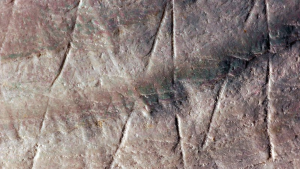This is a Hoot! A Great Horned Owl Swimming
Witnesses said the owl was forced down into lake Michigan by some falcons that were attacking it. No footage of that has surfaced. The owl reportedly swam away before rescuers could ‘help.’
Coolest video I’ve seen this week…
Another super cool science story…Note the assumptions made in the story…
maybe our ideas of early humans and dating is wrong?
Zigzags on a Shell From Java Are the Oldest Human Engravings
On the banks of the Solo River in Java, Indonesia, 19th-century physician Eugene Dubois uncovered an astounding fossil find: the bones of what appeared to be an ancient human, surrounded by animal remains and shells. Excavated in the 1890s, the site gained fame as the home of “Java Man,” better known today as Homo erectus.
Dated to between a million and 700,000 years old, the bones immediately provoked controversy, because Dubois claimed they showed evidence of a transitional species between apes and humans. It turns out he was right—Homo erectus fossils have since been found in Africa and elsewhere in Asia, and it is possible the species is a direct ancestor of our own. But it’s the palm-sized shells found alongside the Java remains that are raising big questions today. An examination of the shells published in Nature suggests that Homo erectus may have used the shells for tools and decorated some of them with geometric engravings. At around half a million years old, the shells represent the earliest evidence of such decorative marks and also the first known use of shells to make tools.
The images showed markings on the shells, at first invisible to the naked eye. “It’s strange to see a zigzag pattern on such old fossil shells,” recalls Joordens.
Viewed up close, one fossil Pseudodon shell from Java shows evidence of engraving. (Wim Lustenhouwer, VU University Amsterdam ) Intrigued, the researchers compared the Dubois shells to how living mollusks were arranged and buried in the wild. The patterns didn’t match up. Most of the shells also had weird holes corresponding to the where the organism’s adductor muscle and ligament, used to open and close the shell, would have been attached. Presumably, someone or something was trying to pry open the shell and remove the gooey mussel. Back then, shellfish eaters such as otters, rats and monkeys also lived on Java. Figuring out what could have poked holes in the shells required some experimentation.

